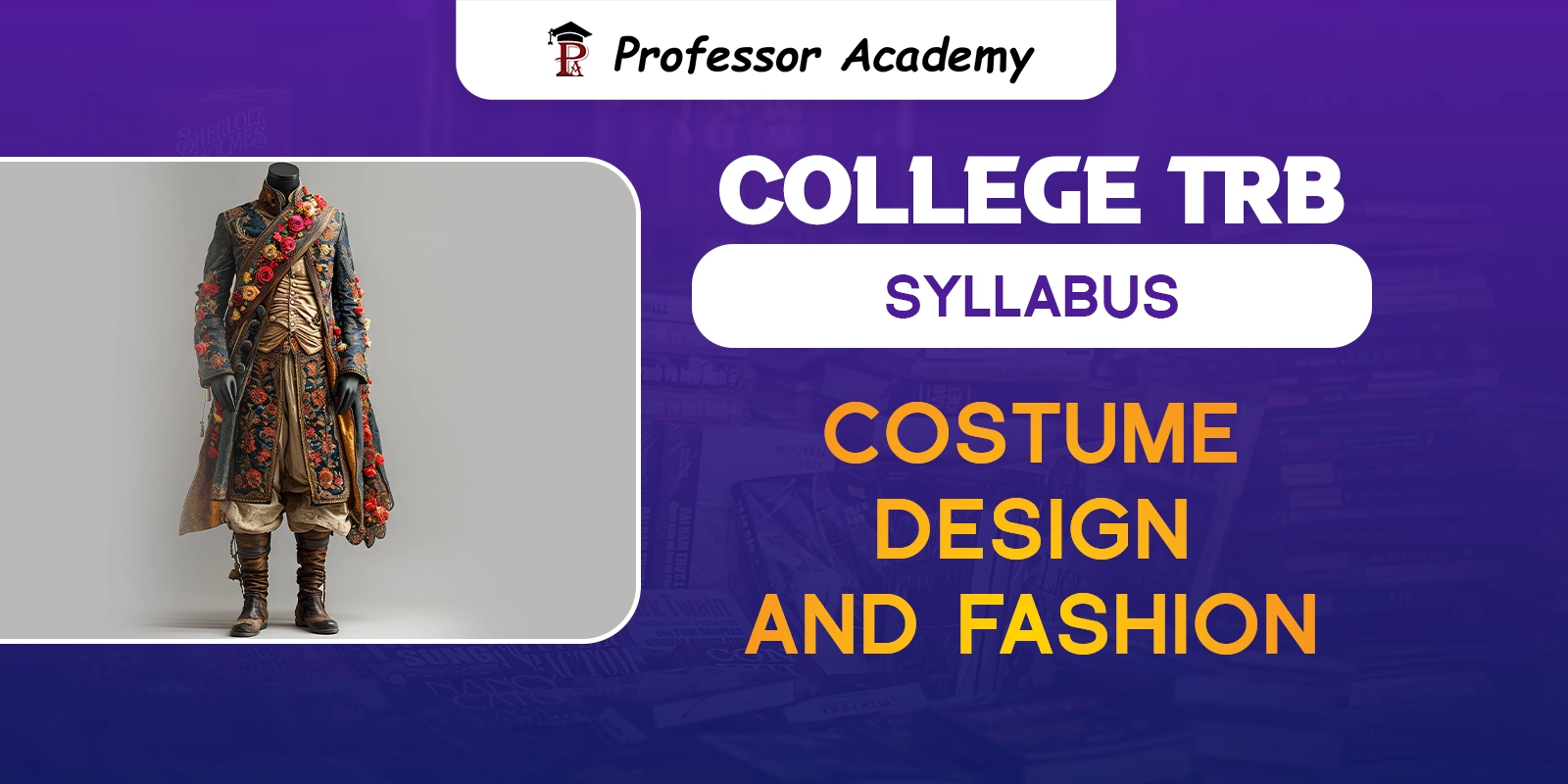TN TRB Assistant Professor Syllabus – COSTUME DESIGN & FASHION

Introduction
The TN TRB Assistant Professor Costume Design & Fashion Syllabus provides a comprehensive structure for candidates preparing for the Tamil Nadu Teachers Recruitment Board (TRB) examination. The syllabus covers essential areas such as textile science, garment construction, fashion illustration, apparel production, and costume design. It also includes topics on fashion marketing, merchandising, fabric analysis, and sustainable fashion practices. This syllabus helps aspirants build a strong foundation in both creative and technical aspects of fashion education, preparing them for teaching and research roles in the field of Costume Design and Fashion.
TN TRB Assistant Professor Costume Design & Fashion Syllabus
UNIT – 1 : Apparel Designing, Manufacturing and Fashion Designing
Body measurements- Importance and procedure. Pattern Making –Types; Drafting, Draping and Flat pattern making. Methods of transferring pattern markings. Grain–Importance and types; Pattern
alteration- Importance and principles. Fitting- Standards of good fit. Pattern layout- Purpose and types. Pattern grading. Spreading- Requirement and methods, Marker planning, marker efficiency and methods of marker planning,
Cutting-objectives and methods. Sewing machineries. Sewing federal standards for Seams and stitches.
UNIT – 2 :
Design- definition and types; Elements and Principles of design and its application to apparel.
Colour theories-Prang and Munsell; Dimensions of colour; Standard colour harmonies. Fashion-Terminologies; Fashion cycle – Length of fashion cycles; Adoption of Fashion theories- Trickle down, trickle up and trickle across. Fashion forecasting–Need and techniques; Factors affecting fashion; Selection of clothing for different age groups.
UNIT – 3 :Textile Science and Textile Processing
Fibre–Definition, Classification, Identification, Manufacturing process of major natural and man made fibres, properties and their end uses. High performance fibers. Yarns–Definition and types. Spinning–Definition and classification; Chemical and Mechanical spinning; blending, opening, cleaning, doubling, carding, combing, drawing, roving, spinning. Different methods of fabric construction – Weaving- Mechanism, Parts and Functions of a simple loom; Classification of looms – Shuttle and shuttle less. Types of weaves. Knitting – Warp and Weft knitting. Non-woven–Definition and types-Web formation–Application and end uses. Developments in spinning, weaving, knitting and non-woven’s.
UNIT – 4 : Preparatory Processes
Desizing, Scouring and Bleaching- need and methods. Mercerizing and Degumming processes. Dyeing: Classification of dyes- Direct Vat, Sulphur, Napthol, Reactive, Acid, Basic and Disperse dyes. Stages of dyeing. Natural dyeing-Sources, extraction, Mordants- definition, need, types, Mordanting techniques, Dyeing procedure. Printing: Direct, discharge and resist styles. After treatment of printed fabrics. Digital Printing. Finishing- Definition and classification. Basic finishes. Special finishes- Antimicrobial, UV protection, Water repellent, fragrance, flame retardant and crease resistance. Plasma, Microencapsulation and Nano finishing techniques. Recent developments in Dyeing, Printing and Finishing.
UNIT – 5 : Textile Testing and Technical textiles
Selection of samples for testing. Standard R H and temperature for testing. Fiber testing- Fiber length, Fineness, Maturity, Strength, Determination of trash and lint in cotton. Yarn Testing- Yarn numbering system, Yarn count, Strength, Twist, Evenness, Hairiness. Fabric testing- Fabric Particulars –length, width, crimp, GSM, Cover factor, Fabric thickness, Fabric Strength–Tensile, tearing, Bursting strength, Fabric Abrasion, Fabric Pilling, Fabric drape, Fabric Stiffness, Fabric crease resistance and crease recovery measurements, Absorbency, Wicking, Shrinkage. Garment testing-Seam strength and seam slippage. Colour fastness–Crocking, perspiration, sunlight, laundering, pressing and dry-cleaning. Computer colour matching. Evaluation of antimicrobial activity, comfort properties. Standards for various tests.
UNIT – 6 :
Technical Textiles- Definition and scope, Classification and application of technical textiles–Mobile Tech, Sport Tech, Agro Tech, Pack Tech, Geo Tech, Med Tech, Build tech, Home textiles, Protective textiles, Smart and Intelligent textiles -Functions, Fibers used, Properties of fibres and areas of application. Latest trends in technical textiles. Testing of technical textiles.
UNIT – 7 : Sustainable Textiles and fashion
Sustainable textiles – definition and importance, Corporate Social Responsibility in the textile and clothing sector, Environmental Management Systems. Sustainability in Dyeing, Finishing, Processing-Enzymatic processing, Ecofriendly textile fibres. Sustainable Fashion – meaning and significance; Environmental concerns related to fashion; Linear fashion and circular fashion.
UNIT – 8 :
4R’s in sustainability –Repair, Recycle, Reuse and Reduce. Moving towards sustainable fashion–Eco fashion, Zero waste designing upcycling & recycling, Slow fashion; Environmental impact of fast fashion. Terminologies related to sustainable fashion- Sustainable clothing, Eco design, Eco label, Eco mark, Green washing, Zero waste design, Green consumer.
UNIT – 9 : Quality Control and Management
Definition and scope of Quality control, Apparel Quality testing –Quality standards and specification, Quality parameters and defects of fabrics and garments. Inspection – Incoming and raw material inspection: Fabric inspection – 4-point system. In process / on-line inspection during spreading, pattern making, cutting, sewing and ironing. Final inspection: Sampling plans and AQL charts–Level of final inspection. Packing & packaging quality tests. Care labelling.
UNIT – 10 :
Quality management-Basic concepts of Total Quality Management (TQM) –Principles of TQM–Quality Trilogy–Four pillars of TQM–PDCA cycle & PDSA cycle–Kaizan concept–5‟S Philosophy–Quality circles. Application of seven QC tools in apparel industry. Quality Standards–Definition of a standard, benefits of standards. Understanding of ISO 9001:2000 standards.
Download TN TRB Assistant Professor Syllabus – COSTUME DESIGN & FASHION: https://professoracademy.com/wp-content/uploads/2025/10/COSTUME-DESIGN-FASHION-SYLLABUS.pdf
Join our College TRB Tamil Eligibility & Descriptive Paper Coaching: https://professoracademy.com/courses/tn-trb-assistant-professor-tamil-eligibility-paper-2-only/
Join Our College TRB Coaching: https://professoracademy.com/product-category/college-trb
Conclusion
The Costume Design & Fashion syllabus for the TN TRB Assistant Professor exam serves as a complete guide for candidates aspiring to become educators in the fashion and textile domain. By integrating design theory, practical application, and industry knowledge, this syllabus equips aspirants to train future designers with skill and innovation. With consistent preparation, candidates can confidently approach the exam and contribute to the growth of fashion education through creativity, sustainability, and academic excellence.
For More Information !
Contact Us : +91 7070701005 / +91 7070701009 / +91 8124408794 / +91 7550100920

